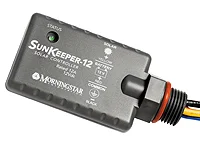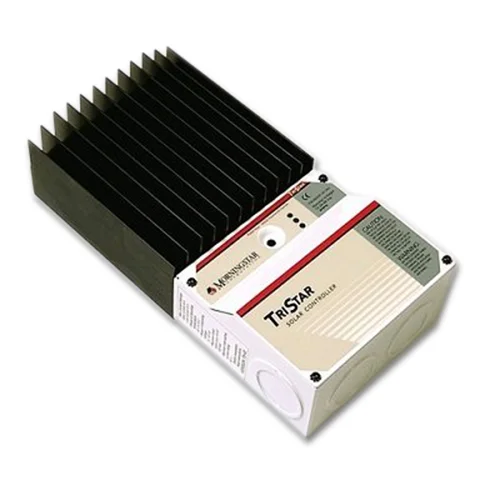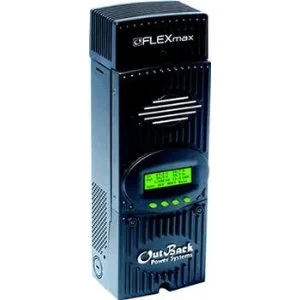Solar Charge Controllers
A charge controller, or charge regulator is basically a voltage and/or current regulator to keep batteries from overcharging. It regulates the voltage and current coming from the solar panels going to the battery. Most “12 volt” panels put out about 16 to 20 volts, so if there is no regulation the batteries will be damaged from overcharging. Most batteries need around 14 to 14.5 volts to get fully charged.
Charge controls come in 3 general types
Simple 1 or 2 stage controls
which rely on relays or shunt transistors to control the voltage in one or two steps. These essentially just short or disconnect the solar panel when a certain voltage is reached. For all practical purposes these are dinosaurs, but you still see a few on old systems – and some of the super cheap ones for sale on the internet. Their only real claim to fame is their reliability – they have so few components, there is not much to break.


Maximum power point tracking (MPPT)
such as those made by Midnite Solar, Xantrex, Outback Power, Morningstar and others. These are the ultimate in controllers, with prices to match – but with efficiencies in the 94% to 98% range, they can save considerable money on larger systems since they provide 10 to 30% more power to the battery. For more information, see our article on MPPT.
Simple 1 or 2 stage controls
which rely on relays or shunt transistors to control the voltage in one or two steps. These essentially just short or disconnect the solar panel when a certain voltage is reached. For all practical purposes these are dinosaurs, but you still see a few on old systems – and some of the super cheap ones for sale on the internet. Their only real claim to fame is their reliability – they have so few components, there is not much to break.

Integrated charge controller circuitry
Circuitry that functions as a charge regulator controller may consist of several electrical components, or may be encapsulated in a single microchip, an integrated circuit (IC) usually called a charge controller IC or charge control IC.
Charge controller circuits are used for rechargeable electronic devices such as cell phones, laptop computers, portable audio players, and uninterruptible power supplies, as well as for larger battery systems found in electric vehicles and orbiting space satellites
Charge controller circuitry may be located in the battery-powered device, in a battery pack for either wired or wireless (inductive) charging, inline with the wiring, or in the AC adapter or other power supply module.
How does a solar charge controller work?
A solar charge controller is an important system component that regulates the voltage generated by solar panels. Charge controllers help to properly maintain your solar power system batteries by stopping them from being over or under charged, and they help ensure maximum battery life. Considered to be among the best in the industry, Xantrex Charge Controllers manufactures only the highest in quality and reliable components. Blue Sky Energy offers charge controllers for rv and marine solar battery charging applications.
You may not always need a charge controller. It depends on the size of your solar power system. Generally, 1 to 5 watt systems designed for trickle-charging batteries will not require one. A general rule of thumb is if the panel’s output is less than 1/60 of the battery’s rated charge capacity, you probably will not need a charge controller.
The solar charge controller regulates the 16-20 volt output of a typical 12 volt solar panel, reducing it to only the voltage required by the battery to keep it at maximum operating level. This voltage will typically range from 10.5 to 14.6 volts, depending on the type of battery, the temperature of the battery and the state of battery’s charge at any given moment.
There are all kinds of charge controllers and they come in all shapes and sizes. They range from 4.5 amp units all the way up to the 60 amp programmable units with computer interface. Most controllers come with either a simple LED or digital displays. Some charge controllers now have built-in computer interfaces for monitoring and control.



